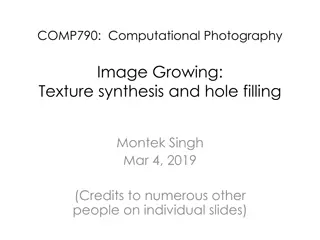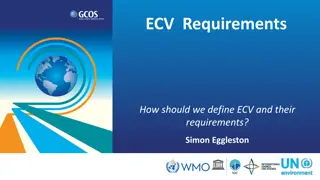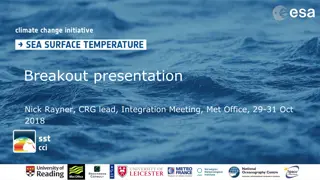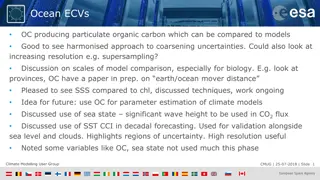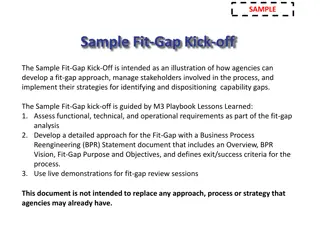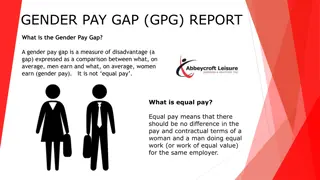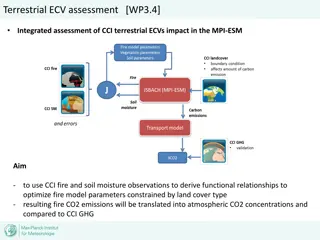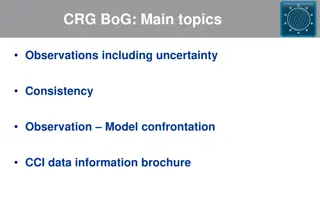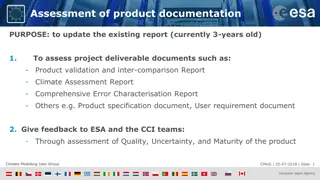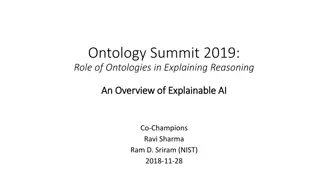Challenges and Feasibility of Explainable AI and Gap Filling for CCI ECVs
Explainable AI (XAI) addresses the need for human-understandable AI models, contrasting with black box approaches. Intelligent gap filling for CCI ECV data is crucial but lacks efficient methods. Machine Learning can enhance EO data analysis with XAI insights, necessitating collaboration between domain and AI experts. Recommendations include integrating ML techniques into data assimilation and enhancing education on AI within the CCI community.
Download Presentation

Please find below an Image/Link to download the presentation.
The content on the website is provided AS IS for your information and personal use only. It may not be sold, licensed, or shared on other websites without obtaining consent from the author.If you encounter any issues during the download, it is possible that the publisher has removed the file from their server.
You are allowed to download the files provided on this website for personal or commercial use, subject to the condition that they are used lawfully. All files are the property of their respective owners.
The content on the website is provided AS IS for your information and personal use only. It may not be sold, licensed, or shared on other websites without obtaining consent from the author.
E N D
Presentation Transcript
CCI Session 4 - Identified science challenges & feasibility of potential AI solutions Breakout Group 4a # Explainable AI (XAI) on CCI ECVs # Intelligent Gap Filling for CCI ECVs Science challenges & feasibility of potential AI solutions # Explainable AI on CCI ECVs # Intelligent Gap Filling for CCI ECVs Facilitator: Carsten Brockmann Rapporteurs: Pierre Defourny and Carsten Brockman ESA UNCLASSIFIED - For Official Use ESA || Slide 1
Explainable AI on CCI ECVs The fact that AI explores data and finds relationships without an underlying model, sometime called black box , can also be considered as a weakness. Diagnostics and predictions derived by AI, in general, does not provide explanations why certain relationships exists. It enables us to model numerically the dependency of one variable from another, but it does not allow us to understand why this relationship exists. Explainable AI (XAI), also referred to as Interpretable AI, or Transparent AI, refer to techniques which can be trusted and easily understood by humans. It contrasts with the concept of the black box. ESA UNCLASSIFIED - For Official Use ESA || Slide 2
Intelligent Gap Filling for CCI ECVs Gap filling methods for CCI ECV data which are both scientifically reasonable and sufficiently computationally efficient do not yet exist. Although not as scientifically rewarding as other future concepts listed, the need for gap filling amongst the CCI ECV projects remains high and an intelligent solution should be considered as low-hanging-fruit. ESA UNCLASSIFIED - For Official Use ESA || Slide 3
Group 4a Explainable AI on CCI ECVs # Intelligent Gap Filling for CCI ECVs Q1: Machine Learning can help us very much in exploiting EO data archives and improving forecast and projections, with (XAI) or without (AI) insight into causes and context of action. How important do you consider XAI, even it comes at the cost of less quantity of results? XAI is a very wide topic which can include many things. It needs to be applied close to the domain scientists. AI experts are required to correctly apply it and to insure the results make sense. XAI explaining parameter behavior in our models would be of great interest for the discipline ML is often considered as a Data Assimilation (DA) technique but the opposite is also true. Optimising state variables within models through DA maybe the most promising field to use ML techniques. Complex equations can be broken down and disentangled into submodels, some being replaced by ML models. Similarly, empirical-based models could be replaced or supplemented by ML (SST) ML should provide uncertainties and should use the uncertainties provided in CCI dataset Recommendations: CCI development should always include domain experts and ML experts! Data assimilation and supplementing current sub-models could be important ML contribution combining observation and models ML should use the uncertainty provided in CCI, and likewise provide it as part of its output. Education on state-of-the-art AI of the CCI community as additional incentive to enhance its use ESA UNCLASSIFIED - For Official Use ESA || Slide 4
Group 4a Explainable AI on CCI ECVs # Intelligent Gap Filling for CCI ECVs Q2: XAI can be used in combination with a (physical/biological/ ) model, either in EO processing, or climate models assimilating EO data. Where do you the need and a possibility to further develop this technique? Emulators (e.g. fro RT Models, land surface models) can be very attractive (see also presentations on emulators) and could reduce computationally intensive processing; For Ocean temperature, it would be of interest to explore emulation for near-surface diurnal dynamics Hybrid approaches: physical models with corrections from ML technique; typically for error correction. On the other hand, it is important to constraint ML to make sure that physical laws are not broken Hybrid approach should run on level 2 dataset and not on level 1 to contribute more efficiently Biological models often rely on simplistic parametrization which could be improved using ML, learning about the natural variability and building on comprehensive observation datasets For CO2 and CH4, their demanding accuracy requirements and biases depend on many parameters in a complex way. Random Forest is already used for quality flagging and bias correction in GHG-CCI. Recommendations: Emulators have promising potential to be explore Hybrid approaches combining the advantages of both physical models and ML techniques appear as a safer approach for further developments ESA UNCLASSIFIED - For Official Use ESA || Slide 5
Group 4a Explainable AI on CCI ECVs # Intelligent Gap Filling for CCI ECVs Q3: How can cross ECV analysis, investigations of cycles (energy, carbon, ) benefit from explainable AI? Where are the hooks in analysis methods and models for AI that eventually provide us explanations? Understanding interactions and relationships between variables in models would help a lot XAI could be used to explore interactions and relationships between ECVs where physical laws are lacking, typically for the land ECVs between LC, fire, biomass and soil moisture. Understanding causal relationships from patterns of change within long ECV time series could improve significantly land cover change models currently empirically calibrated or based on simple economical rules. Anthropogenic activities often produce complex patterns at different scales which can not be described by laws. Recommendations: ML should enable to understand many relationships between ECVs in models on one hand and directly from ECV datasets on the other hand XAI should allow to explore land processes related to anthropogenic drivers, using long and rich ECVs datasets and could support land cover land use change modeling ESA UNCLASSIFIED - For Official Use ESA || Slide 6
Group 4a Explainable AI on CCI ECVs # Intelligent Gap Filling for CCI ECVs Q4: Is consistency between ECVs a problem? Can AI and XAI help us to identify inconsistencies and how can we apply it to indicate reasons? ML may help to identify cases where ECV disagree outside the expected range given by uncertainties. Not many inconsistencies have been reported. Do we have inconsistencies that what we document ? SL budget closure is a good example to apply XAI and address Q2-4 on the ECVs used in SLBC Pattern inconsistencies would be very interesting to detect with AI (e.g. high temperatures patterns & desert patterns?). More complex interactions involving several ECVs (like the terrestrial ECVs). Recommendations: Inconsistencies between ECVs need to be investigate more systematically (to further improve ECVs individually but also to deliver a consistent CCI dataset) Complex patterns of inconsistencies could probably be detect only by AI ESA UNCLASSIFIED - For Official Use ESA || Slide 7
Group 4a Explainable AI on CCI ECVs # Intelligent Gap Filling for CCI ECVs Q5: An important prerequisite for cross ECV analysis is adjusting data on spatio-temporal grids (CCI toolbox / datacube). Can AI help us to perform this step in such a way to preserve (statistical) characteristics of the data and thus improve interpretability of datacube for climate applications? This is confirmed to be an issue. Intelligent Gap filling seems of critical interest for many, e.g. to reduce the computational overhead (OC, SST, Sea Ice) of gap filling and having good methods to fill gap would rewarding There are two types of gaps: Observational gaps (EO instruments do not see close to the pole or persistent cloud cover prevent to observe) Less capable sensors may fill gaps from more capable sensors but better methods should be used. Users require gap filled products and some ECVs (SST, OC, Aerosol, SeaIce) already spent some effort (also outside) but more needs to be done. Gap filling may lead to averaging out (or even removing) extreme events Problem may be with highly dynamic ECVs, like snow. cross-variable gap filling process that takes into account cross-correlation between variables and spatiotemporal context (see PhD of V. Bessenbacher for SM and LST for SM gap filling) Recommendations: Intelligent Gap filling is much needed for many ECVs to reduce computing load, to improve the records consistency and possibly by exploiting cross-variable correlations ESA UNCLASSIFIED - For Official Use ESA || Slide 8




